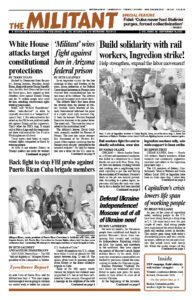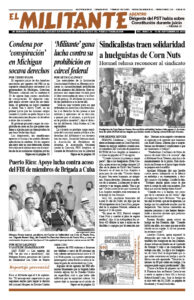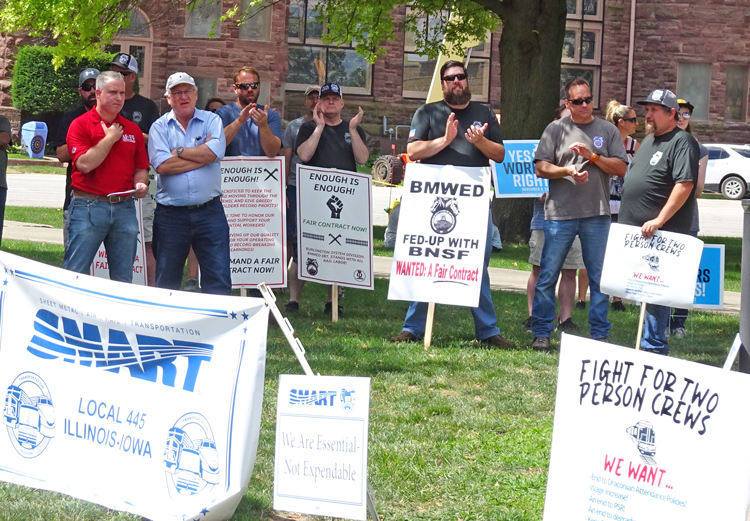CHICAGO — Mario Aurelio Navarro, a 49-year-old experienced conductor, was killed in a derailment in a Union Pacific rail yard in El Paso, Texas, Aug. 29. Two cars derailed, crushing Navarro and crashing into a neighboring backyard, rupturing a gas line and forcing the evacuation of 50 residents. Navarro’s death on the job was entirely preventable. According to a police report, supervisors told him the track was clear, but in fact a derailer had been installed there when work was done on the track earlier.
“Brother Navarro is the fourth TD member who has died while in service in 2022,” said a statement issued by SMART-TD, the conductors’ union.
This latest fatality underscores the fact that the rail bosses’ drive for profits, which has led them to slash crew size and impose unlivable and dangerous schedules, is a crucial question.
These questions are not addressed in the proposed national contract for over 115,000 rail workers organized by a dozen different unions who are facing off against five Class 1 railroads and some 30 local carriers.
The contract for the majority of the unions ran out at the end of 2019. Under the notorious anti-union Railway Labor Act, they entered mandatory talks organized by the National Mediation Board in June 2021. Those talks were unsuccessful and ended June 14 this year, followed by a 30-day “cooling off” period. Then Joseph Biden imposed a Presidential Emergency Board to draw up proposals, which it issued Aug. 16.
Most of the rail unions, under pressure from workers, have said the recommendations are not acceptable and are continuing negotiations. If a settlement is not reached by Sept. 16, the unions are legally free to strike, and the rail bosses are free to lock out workers.
The board recommended a pay raise of about 24% over five years, some of it retroactive, and the bosses have ballyhooed this as the largest in decades. But most, if not all, of the raise will be eaten up by high inflation and increases in health insurance costs. And the proposal does nothing to address the issues of exhausting work schedules, draconian attendance policies, job cuts and speedup.
Overall, the rail bosses have slashed the workforce by 29% over the last six years, resulting in soaring profits. Now the carriers want to impose engineer-only operations on road trains, and have been cutting yard crews to the bone.
One-person ‘crews’
On Aug. 9 CSX unilaterally turned what had been two-person remote control switching crews into one-person jobs in its Selkirk yard near Albany, New York. “Since then, Selkirk employees have been harassed, intimidated, and bullied into accomplishing more work with half the crew,” Joshua Therrien, chairman of SMART-TD Local 212, wrote in a letter to the federal Surface Transportation Board.
“My people were already fatigued and beat down from the employee shortage,” Therrien said. Now “my members are being forced to work 12 hours vs. 8 hours because the state of the railroad is in shambles. … They are being yelled at on the radio, met by management in the field and being harassed for not moving quicker, or doing more, and when they can’t find any rule violations, they are flying a drone over our heads 24/7.”
The railroad issued a statement saying, “CSX strongly refutes the allegations of harassment and intimidation.”
Therrien also accused CSX of skimping on routine maintenance in the Selkirk yard. “Crews are operating switches that are hard to operate because there are not enough maintenance workers to properly adjust or lubricate them,” he wrote. “We are walking on road ballast, so that the carrier can save a few pennies on good walking ballast to protect our feet, and we walk around debris.” This description rings true for many rail workers across the country.
“A track crew of three, the same size as it was decades ago, now is responsible for maintaining five times more trackage from our home base in Lincoln into eastern Iowa, including any yard tracks in between, over 100 miles of track and a number of bridges,” Jake Forsgren told the Militant Sept. 3. Forsgren has 11 years as a track worker and welder in Nebraska and is the local chair of Brotherhood of Maintenance of Way Employees Division Lodge 1320.
Track workers travel long distances, at times hundreds of miles from their home base. Travel allowances paid by the companies were last adjusted in 1996 and meals and lodging have not been raised since 2005.
The Presidential Emergency Board acknowledged the BMWE “provided scores of anecdotes of employees who were forced to sleep in cars, skip food or eat nothing but fast food, sleep in substandard hotels with bed bugs and criminal activities taking place on premises, or sleep multiple employees in a room even during the COVID pandemic.”
“So far, our national negotiating leadership has been unsuccessful getting a contract with railroad companies,” Forsgren said. “Strike ballots of BMWE members were counted the last week of August, resulting in over 97% for a strike if an agreement isn’t reached.”
History of government intervention
The rail bosses’ profit drive, crew cuts and resulting worker resignations have led to many delays in servicing customers. Some major capitalist businesses have appealed to the federal government to intervene. In June the Surface Transportation Board issued an emergency service order directing Union Pacific to prioritize corn shipments to Foster Farms, after the poultry giant complained it might have to euthanize millions of chickens for lack of feed.
But the business associations and government agencies, such as the Surface Transportation Board, are united in their opposition to any strike action by rail workers to fight against their conditions. They are counting on Congress to rapidly order a halt to any work stoppage, as it has done many times in the past.
The last national rail strike took place April 17, 1991, after three years of negotiations, mediation and “cooling off” periods. One of the major issues was the rail bosses’ drive to cut what were four- or five-person crews to two. The strike showed the tremendous power workers have. Virtually all freight ground to a halt.
By the end of the day, Congress passed legislation ordering the strikers back to work, and the unions complied. The vote was overwhelming and bipartisan, with only five representatives opposed. Most of the bosses’ concession demands were imposed.
This record “proves more clearly than ever that organized labor needs its own political party and not the so-called friends of labor in the Democratic and Republican parties,” Joe Swanson, a retired rail worker and the Socialist Workers Party candidate for Congress in Lincoln, told the Militant. “The SWP campaign supports the formation of a labor party that would fight for abolition of the Railway Labor Act, which severely limits the right of rail workers to strike.
“Rail workers have historically honored the picket lines of other unions when they go on strike, as they did in the 2021 Bakery, Confectionery, Tobacco Workers and Grain Millers Local 50G strike at Kellogg’s in Omaha,” Swanson said. “Such acts of solidarity by the entire labor movement can both help and inspire others to stand up and fight. All out in support for the railroad unions in their struggle for a contract and for schedules and crew sizes that protect workers’ health and welfare. This is in the interest of all workers.”
Naomi Craine is a freight conductor and member of SMART-TD.


